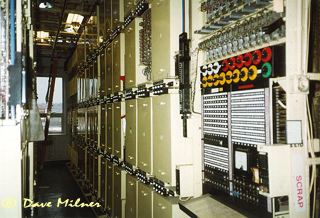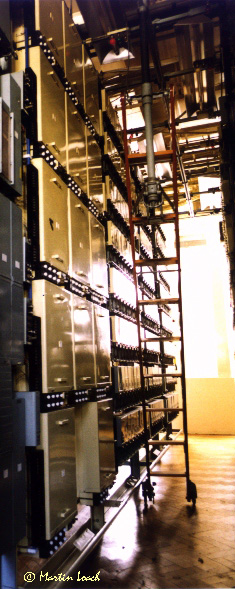The 'Dial Everywhere' Network
 |
GRACE was developed as the technology of Subscriber Trunk Dialling evolved during the 20 years it took to deploy throughout the UK. |
Overview
As Subscriber Trunk Dialling (STD) was introduced, each exchange was provided with the necessary Group Routing And Charging Equipment otherwise known as Register Translators.
Rollout
In England
Bristol (Central) was the very first exchange to be provided with STD access in December 1958.
Midland Region
Evesham was the third exchange to get STD access at 3.0 p.m. on Wednesday 6 January 1960 with 40 RARS (Register Access Relay Sets), 12 registers and 2 translators. The Deputy Director General, Mr R.J.P. (now Sir Robert) Harvey, C.B., made the inaugural call to London, to Sir Rupert de la Bere, ex-M.P. for Evesham and Freeman of Evesham.
London Telecommunications Region
On 1st July 1960, the Assistant Postmaster-General, Miss Mervyn Pike, MP, made the inaugural call from a Watford telephone to the Mayor's parlour at Leicester. Watford exchange was initially equipped with 357 RARS, 45 registers and 3 translators. Each translator normally serving 15 registers.
City of London Telephone Area
The first centralised unit, for the London Director Area, was the Citadel Exchange, which was brought into service on 1st July 1961. Initially it allowed STD access from the Metropolitan, Moorgate and London Wall exchanges. Thus the inaugural call from City Area was made on 3rd July 1961 by the Lord Mayor, Sir Bernard Waley-Cohen, to the Lord Mayor of Bristol.
Mansion House Exchange was the 644th exchange to have STD access. It was the first of the (then 56) Telephone Areas to have completed its programme of installations. To mark the occasion, the Lord Mayor of London, Alderman C. James Harman dialled the first trunk call from Mansion House on 14th January 1964.
In Scotland
Subscriber Trunk Dialling began with the conversion and modernisation of Dundee main exchange which took place at 8.0 a.m. Saturday 11 June 1960. The STD and trunk automatic equipment comprised 52 RARS, 13 registers, 2 translators, 250 motor uniselectors and AC1 and DC2 relay-sets for trunk signalling.
A separate inauguration ceremony to mark the introduction of STD in Scotland was held on Tuesday 14 June 1960 by Sir Robert Harvey, KBE, CB, the Deputy Director General and the Lord Provost of Dundee. The Assistant Postmaster-General, Miss Mervyn Pike, MP, answered an STD call (from the Lord Provost) in her home.
Glasgow
Was the very first Director Area in the UK to get STD at 8 a.m. on 6th May 1961. It was also the first Post Office installation to use magnetic-drum type Register Translators. The official ceremony was held on 8th May 1961 when the Lord Provost dialled a call to the Lord Mayor of Liverpool.
The Equipment
During the 'Strowger Era', 14 variations of Register Translator equipment was produced from 1958 when STD was first introduced up to 1979 and the dawning of the 'Digital Era.'
 |
During the 'Strowger Era', 14 variations of Register Translator equipment was produced from 1958 when STD was first introduced up to 1979 and the dawning of the 'Digital Era.' |
Type 2- The Electro-mechanical Relay Controlled RT's used 3000 type relays and type 2 uniselectors and was suitable for a single charge group only.
Type 3- As above, but could serve up to 3 charge groups. Later versions of the electro-mechanical type RTs used type 4 uniselectors in place of the larger type 2s.
Type 4-The Magnetic-Drum RTs with thermionic valves and a magnetic drum storage system were used extensively in Director Areas. The first Magnetic Drum Director was trialled at Lee Green exchange, London in 1958.
Type 5-Was introduced to give the necessary MF2 signalling facilities for use with the Transit Network.
Type 6-In 1965 was the first to use transistors and ferrite cores to provide translation facilities on incoming routes to Director areas.
Type 7/8/9 Not known.
Type 10-Was an electro-mechanical type, but used transistors in the timing circuits. Provided in Non-Director areas to accept MF2 signalling from the Transit Network.
Type 11
Type 12-A Stored Program Control Director (SPC) produced in the late Sixties which used ferrite cores, transistors and diodes.
Type 13-The Metal-Oxide-Semiconductor-Transistor (MOST) Director was produced in 1979 making use of custom designed integrated circuits.
Type 14-A Processor-Controlled RT using the GEC MK1P processor with a CPU and RAM making it fully software controlled. A replacement for the type 4 RT as well as the 2, 3 and 5s.
Trunk Switching Units
Magnetic Drum Type 4 RTs
Bastion, an STD Outgoing Trunk Switching Unit (in London) opened during 1968. This supplemented the existing central London STD units, Citadel, Fortress and Tower.
Postscript
Group Switching Centres which used the electro-mechancial RTs were particularly noisy as there was an almost continuous concentration of heavy traffic switching as incoming callers from a wide catchment area seized the equipments, and the type 4 uniselectors pulsed out the translated digits.
All logos and trade marks are the property of their respective owners and are used on the Light Straw site(s) for review only. Students and researchers are recommended to make their own independent enquiries as to the accuracy of the information contained therein.